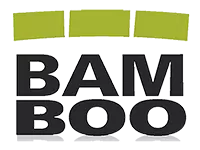Updated on April 26, 2025
Punching Power “Leaks”: How Bad Posture Lowers Punching Power
Punching in a straight line is challenging when you have poor posture, specifically the forward-rounded posture.
It is challenging because the improper posture is already high stress on the shoulder joints which is negatively affecting the surrounding musculature. If you have a forward-rounded shoulder posture, you will probably feel tightness and weakness when executing punches. Additionally, the quality of the punch technique is compromised i.e., the punches are less accurate and less powerful. It’s easier to punch accurately when the punches are in a straight line.
How to check for forward-rounded shoulders (postural self-assessment)?
How do know if you have forward-rounded shoulders? You can test your posture by doing the following test:

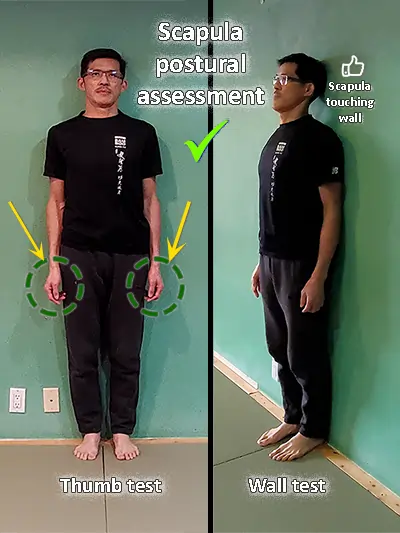
Thumb test
A quick and simple way to test your shoulder posture is the thumb test. Stand in front of the mirror. Observe which direction your thumbs are pointing. Alternatively, you can observe what direction of the opening space between the thumbs and the index fingers is facing. If your thumbs or space between the thumb and the index finger are facing towards each other, you test positive for forward rounded shoulders.
Wall test
If you stand against the wall, the back of your head, shoulder blades and buttocks should touch the wall. If you find it challenging to touch the flat area of your shoulder blades to the wall, you test positive for forward rounding shoulders.
One of the main contributors to rounded shoulders is leaning forward in front of your computer and/or workstation.
Definition of a straight-line punch
The straight-line punch is defined as a punch along the human coronal body plane.
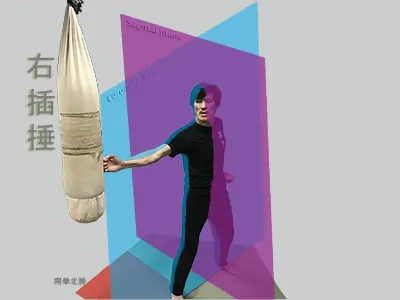
The coronal plane is the imaginary vertical plane that divides the human body into the anterior (front) and posterior (back) portions. Generally, the coronal plane aligns with the spinal column.
In our Buk Sing Choy Li Fut kung fu lineage, this is standard for a straight-line punch. Ideally, this means the practitioner who executes the straight-line punch needs to have good shoulder joint health. With less than reasonably good shoulder joint health, our novice Buk Sing Choy Li Fut kung fu practitioner will find it challenging to execute an effective straight-line punch technique. Therefore, the trainee will need to gradually and progressively improve shoulder joint health, especially its range of motion and posture.
Postural imbalances can cause movement restrictions. The anterior part of the shoulder joint and the chest are contracted and tight while the upper back muscles are weak and taut. There are also smaller stabilizer muscles which hold and keep our shoulder joint from dislocation. These muscles are called shoulder rotator cuff muscles. Usually, the rotator cuffs are weak due to a lack of activity.
Faulty tendencies in straight-line punch
Our most common observations when novice trainees launch a straight-line punch are:
Having a properly aligned technique or in this case, posture is important because it is how we maximize leverage with minimal effort or muscular exertion. In simpler terms, we use less raw muscular strength or brute force. Rather, we want to use the mechanics of the body structure to help us convert the power.
How does excessively elevated and protracted scapula compromise straight-line punching?
In further detail, when we raise our scapula or shoulder blade, our shoulder girdle is more mobile but less stable.
What is the shoulder girdle?
The shoulder girdle is the upper body structure that connects the upper limbs to the axial skeletal structure (skull, neck, ribcage, trunk of body including the spinal column, pelvic girdle) via the scapula and clavicle (collar bone).
Scapulothoracic joint
Within the shoulder girdle structure, the muscles around the scapula hold it close to the posterior portion of the ribcage. The space in between the scapula and the ribcage is known as the scapulothoracic joint. Within the scapulothoracic joint, it is filled with various tissues, muscles, and fluids which allow both bones to smoothly move and glide against each other. When we circle our arm over our head, the scapula moves and glides over the ribcage. The key muscle which secures the scapula close to the ribcage is called the serratus anterior or known as the boxer’s muscles.
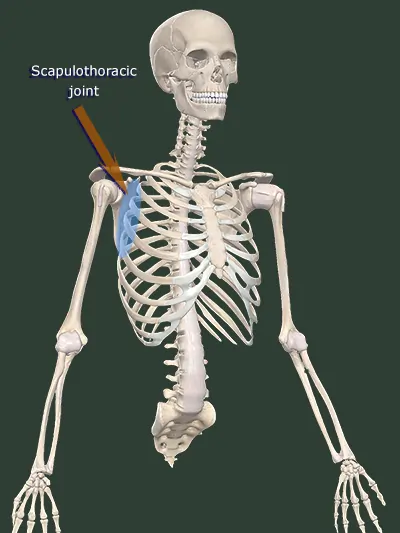
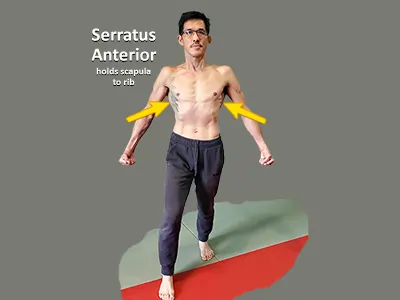
Maximize energy channelling by stabilizing the scapula to the ribcage
The further away the scapula is from the ribcage (which is a portion of the axial skeletal structure), the less stable the shoulder girdle. So, if we elevate and/or roll our scapula forward, the stability of the shoulder girdle is compromised.
In order to channel the maximum amount of power through the shoulder girdle, we need to stabilize the scapulothoracic joint. By depressing the scapula inferiorly (towards the tailbone) and retracting them closer to the ribcage, we can increase the shoulder girdle stability. With this in mind, we still want the ability to raise our arms up to at least shoulder height (90 degrees) with minimal scapula elevation.
In our previous article, we discussed generating power through kung fu stances in our previous article titled Stances - The Most Important Secret in Martial Arts Practice … Read more
Since (as was stated above) we can generate a great amount of power by pushing off the ground to deliver martial art techniques, it is crucial to prevent energy leaks through a “spongy” shoulder girdle structure. Stabilizing the scapulothoracic joint is necessary to deliver an effective straight-line punch.
How does flaring elbows laterally outward affect the straight-line technique?
While launching the straight-line punch, we would need to keep our elbows pointed downwards for as long as we can. By doing so, we can transfer the power more effectively to the intended target.
In principle, we try to simulate our arms and hands into a battering ram, which sets them in a direct line of ramming force to the target.
However, a lot of us tend to flare out our elbows too much and too early in the path of the punch, especially when we want to twist the wrist to rotate the punch.
Force line misalignment
The trajectory of the punch is no longer in a straight line when the elbows flare laterally outward. The arm/fist is not aligned along the coronal anatomical plane (the imaginary line which divides the body into front and back sections). As a result, the punch is not aligned with the spinal column axis of the body and therefore, cannot be directed to an intended target with the body weight behind it. Unintentionally flaring out the elbows can compromise the punching power, weakening the impact and/or potentially causing injury to the shoulder girdle due to misalignment.
Camouflage your punches
The advantage of applying the straight-line punch is camouflaging the technique so that it is not easily seen. It’s harder to see an oncoming small object that is headed directly at you especially if you only have about one second or less to deal with the object.
When the elbow flares laterally outward, the forearms become visible and the opponent can easily see it moving toward the target. This gives the opponent time to react to the punch. Camouflaging the punch by keeping the elbows from flaring, hiding it from the opponent’s view angle and therefore, preventing telegraphing of techniques to the opponent.
Forearm strike or forearm block
The additional bonus to having the elbows tucked in is the ability to use the forearms as a defense technique while simultaneously striking the intended target. As the old wisdom from old kung fu masters stated, - 連銷帶打 or (“lin-siu-daai-daa”) translates to simultaneous block and strike. The following pictures will explain the forearm block and punch.
The Challenges:
As a result of postural imbalances in the neck, shoulder and upper back regions, it is challenging to
Shoulder blade retraction and depression for shoulder girdle stability
With long durations spent curled forward in our daily lives, our chest and front of our shoulder joints become tight and the muscles surrounding the scapula become weakened. Consequently, it is challenging to retract and depress the scapula while attempting to stabilize the shoulder girdle.
Elbows pointed downwards for force alignment
The constant slouching forward contributes to the tendency of flaring out the elbows. Keeping the elbow pointed downwards can be challenging especially when the upper body posture is rounded forward. As stated earlier, the need for scapula stability is crucial to maximizing energy channelling for efficient punching power. This means we need to activate the muscles behind the scapula and upper back i.e., the shoulder girdle, to pull the elbow downwards and at the same time rotate it inwards to the middle of the body.
To a kinesiologist, the movement patterns are known as scapula retraction and shoulder joint external rotation.
A slight elbow outward flaring angle can significantly compromise the effectiveness of the power of the punch. Since our daily lifestyles are dominantly susceptible to forward rounding postures, we are all prone to having tight pectoral and shoulder joint internal rotator muscles. These 2 muscles are the main cause of the outward flaring of the elbows.
The pectoral in the front acts in conjunction with the rotator cuff muscles to perform external rotation of the shoulder. In our case of Buk Sing Choy Li Fut style straight-line punch, keeping the elbow pointed vertically downward is crucial in maintaining good alignment.
If both the pectorals and internal rotators are tight, from the constant slouching, they cannot elongate enough to allow the full range of motion of the shoulder to pull backwards. So, it will be challenging to keep the elbow pointed downward.
Risk of continued training with compensated techniques:
Training without addressing postural imbalances can cause further damage to muscles and joints.
Anybody who is unaware of the issues may unintentionally cause further imbalances, and in the long term can potentially place more pressure on the joints. Essentially, you are “over-activating” one group of muscles, for example, the front muscles, and under-activate the opposing antagonist posterior muscle group.
Strengthening muscles without properly balancing out with stretches will cause the muscles around the joint to tighten. To an unsuspecting novice trainee, you may have been instructed to strengthen (which also adds to the tightness) chest pectorals muscles with push-ups, bench presses, and sit-ups, when what is really needed is to strengthen the back muscles with back and core strengthening exercises e.g., various row exercises, deadlifts, squats. Jumping into volumes of sparring rounds will build bad techniques and eventually, will reinforce a deeper habit of improper techniques. Training without addressing physical issues is like training with blinders on. It’s not targeted training … and adds a lot more time and effort to achieve good quality martial art skills or maybe not at all.
Rehabilitative intervention-Corrective and Prehab exercises
The following are some of the rehabilitative and pre-hab exercises:
- Scapular retraction strengthening-weak mid and lower trapezius muscles
- Trap 3 raises
- Draw bow string (unilateral)
- Sword draws
-
- Scapular retraction and depression
- Horse stance and hands chambering
- Door frame pectoral stretch
- Long staff swing back
- Dumb-bell or cable rotator cuff exercise
- Straight-edged sword twirling
Benefits of good technique and posture:
Having good technique provides better energy stacking or kinetic chain in your martial arts practice. If you can have your centre move your entire body, you are efficiently moving with minimal muscular exertion. Indirectly, you will minimize injury risks. The martial arts skills will gradually and naturally transfer to your daily living physical movements and tasks. In the long term, you are less likely to get aches and pain and lead a better quality of life.
Conclusion
Every martial arts training program should have the following elements: identify and fix issues, re-calibrate and re-train, and increase skill repertoire and performance.
Technique, posture, and body leverage matter, they help us to reduce injury risks in martial arts practice and in our daily lives. Most of the acquired technical skills in martial arts training, if done properly, are transferable to daily living activities.
In the end, improving the art of good technical punching requires repetitive volumes of practice, optimizing and discovering our own personal quirks.
Check out our kung fu classes, and get your posture upright again
You may be interested in:
Kung Fu performance at the 2023 Toronto Chinatown Festival
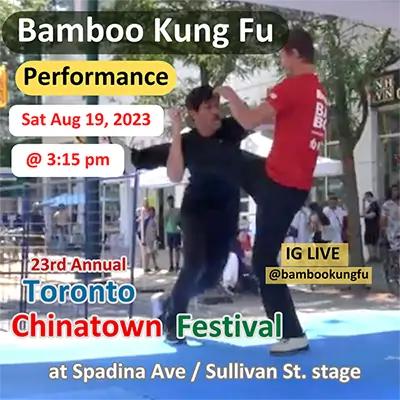
Bamboo Kung Fu students will perform Chinese martial arts on stage at the 23rd Toronto Chinatown Festival on Saturday, August 23, 2023. Our show will begin at 3:15 pm (UTC/GMT -4).
The martial arts show will be held at Spadina Avenue and Sullivan Street.
More - Martial art performance at the 2023 Toronto Chinatown Festival
Stances - The Most Important Secret in Martial Arts Practice
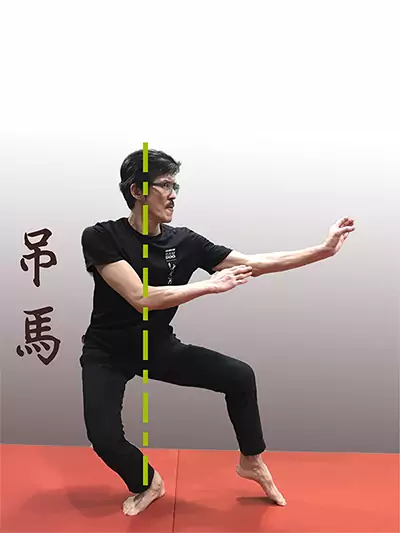
Stance is the ultimate foundation in martial arts practice. Stance is the essence of any kung fu practice. Without it, the quality and leverage of the kung fu techniques will not be effective.
More - Stances: the most important foundation in martial arts practice
Kung Fu Online Live Martial Arts Classes Long Distance Learning
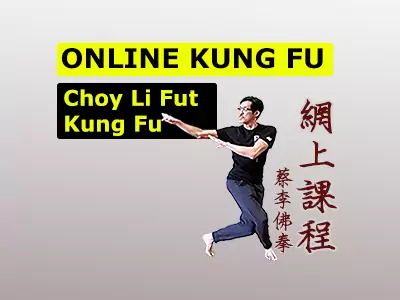
Online live interactive martial arts classes in the comfort of your home. Go to kung fu classes without travelling
More - Online Kung Fu classes
LIVE Online Kung Fu-Blind River, Elliot Lake, Thessalon, Bruce Mines

LIVE Online Kung Fu in the townships of Blind River, Elliot Lake, Thessalon, and Bruce Mines in northern Ontario.
Our online classes are cast LIVE from our location in downtown Toronto. Our online classes are Hybrid classes. This means the online classes are run together with in-person classes.
More - Online Kung Fu-Blind River, Thessalon, Elliot Lake, Bruce Mines in northern Ontario
Adult kung fu
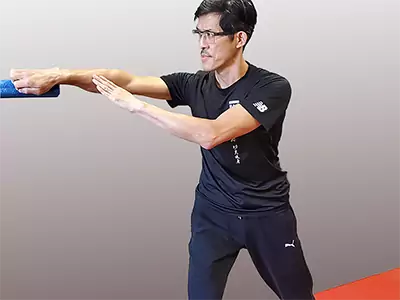
In-person and online options available.
Choy Li Fut kung fu is a dynamic martial art style with a diverse repertoire of movements. Class curriculum:
Primary goal: Improve overall fitness.
Secondary goal: Gain self-defence knowledge, Foster good biomechanics and posture to help you in day-to-day activities of daily living (ADL).
Everyone is welcome, with or without previous martial arts training experience.
More about Adult kung fu
Children kung fu
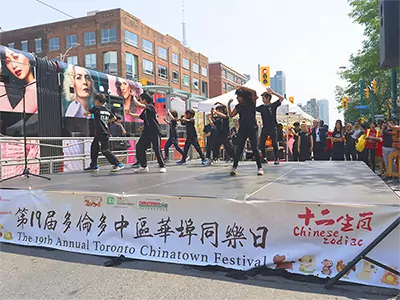
In-person and online options available.
Studies have shown the positive trends of long-term participation in physical activity programs such as martial art. Such programs help improve children’s executive functions i.e., creativity, flexibility, self-regulation, discipline, and working memory functions.
By instilling good movement patterns in the children’s kung fu program, children will gain the foundation which will set them up for a healthy and active lifestyle.
More about Children's kung fu
Essentrics™-stretching, strengthening, mobility full body exercise
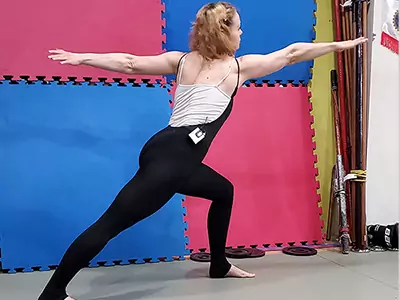
In-person and online options available.
Essentrics™ is a full-body workout that draws inspiration from ballet, Tai-Chi, that develops lean, strong muscles and improves your posture. The fluid and dynamic movements nature of the exercise is low impact and improves joint health. Lighten up your mood and move to the rhythm of the songs playlist.
More about Essentrics™
